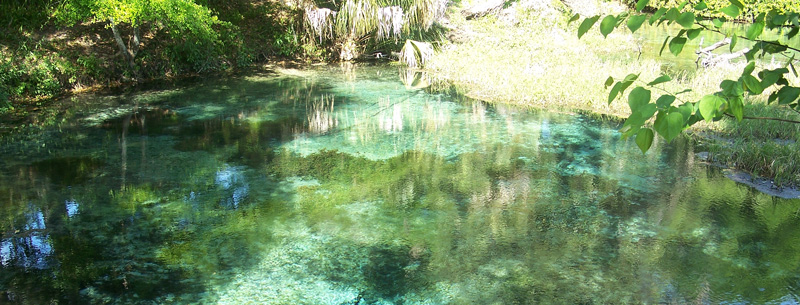Rainbow River Scuba Diving Guide
Rainbow River has attracted and sustained human inhabitants for over 10,000 years. The crystal clear water, abundant wildlife and the discovery of hard rock phosphate began attracting residents and tourists as early as the late 1880s. When Interstate 75 was built, the area declined; however, the entire Rainbow River was recorded as a Registered Natural Landmark in 1972, an Aquatic Preserve in 1986, and an Outstanding Florida Waterway in 1987.

The state of Florida purchased the site in 1990 and with the help of volunteers, the site opened for weekend visitation on March 9, 1995. The park encompasses 1,000 acres comprised of 826 upland acres, 79 wetland acres, and 15 submerged acres. Within Rainbow Springs State Park are nearly a dozen distinct natural communities including sandhill, Flatwoods, upland forest, and hydric hammock. Once the site of extensive formal gardens, a variety of wildflowers and trees remain for the visitors’ pleasure. Wildlife is equally attracted to the area.
Quick Facts about Rainbow River
- Location: North of Dunnellon, Florida
- Directions: Rainbow Springs State Park is located 3 miles north of Dunnellon on the east side of U.S. Hwy. 41. The camping entrance is located 2 1/2 miles north of C.R. 484 off S.W. 180th Avenue St.
- Activities: Camping, swimming, fishing, picnicking, diving, and snorkeling. Canoes and inner tubes are available for rent at the campground. Park facilities are available for special events.
- Admission: $1.00 per person, children five years of age and younger are admitted free.
- Park Contact: 19158 S.W. 81st Pl. Rd., Dunnellon, Florida 34432 Phone:(352) 489-8503

The Rainbow River, from which the park gets its name, starts at the park from a number of spring vents that issue an average of 500 million gallons of crystal clear water every day at a year-round temperature of 72 degrees. The clear waters of Rainbow Springs come from several vents, not one large bubbling one. Rainbow River Park is a popular destination for swimming, snorkeling, canoeing, picnicking, or strolling on the walking trails to enjoy the many plants and animals that abound here. The river itself is home to a wide variety of fish, wildlife, and plants. Many are within easy viewing by visitors.

This biologically diverse park offers outdoor enthusiasts a variety of recreations. There are trails that lead to 60-foot cascading waterfalls, a swimming platform, and a butterfly garden. Anglers, swimmers and snorkeling enthusiasts share clear water with largemouth bass and bluegill. Canoeists find the trail to the campground only 1.5 miles away while enjoying wildlife views of wading birds and the American alligator. Traveling to the large campground via car is a longer trip, approximately 6 miles. The park is not yet a contiguous unit. Canoe and inner tube rentals are available from the park office and campground. Bathhouses and fresh drinking water are added creature comforts.
Visitors to Rainbow Springs State Park enjoy swimming, picnicking, nature study, walking, camping, and canoeing. The park is known for its bountiful azalea garden. Paths stay occupied during the February and March blooming months. The park offers canoe rental at the headsprings day-use area, and canoes and inner tube rental at the campground.

Florida, in general, experiences mild, comfortable winters and warm to hot, humid summers. Summer Fahrenheit temperatures average in the mid to high 80’s (28 – 29 Celsius). Winters are mild and dry with temperatures averaging 58 – 64 degrees Fahrenheit (14 – 18 Celsius). Precipitation for the central area averages anywhere from 56 inches to less than 52 inches per year. The region offers a great warm escape for outdoor recreation during the cold northern months. August and September are peak months of the hurricane season that lasts from June 1 through November 30.

Because the Rainbow River is such a popular attraction, there are a number of regulations in place to protect it. No tubing is permitted within 1800 feet of the headsprings. Snorkeling and swimming are restricted to the buoyed swimming area to prevent injuries and uprooting of water plants. Motors are not allowed in the restricted area and you are not allowed to anchor, land, or get out of your boat other than at the designated canoe dock. The restricted area is blatantly marked by a buoy placed in the center of the river. County ordinances applying to the entire Rainbow River include no fishing within 1 mile of the headspring; it is only permitted possess alcoholic beverages or to have any food or drink stored in a reusable container; you must use the appropriate “diver down” flag if snorkeling or scuba diving; vessels must go idle speed and cannot cause a wake. If everyone follows these rules, the Rainbow River will be cleaner, safer, and protected for future generations to enjoy.

